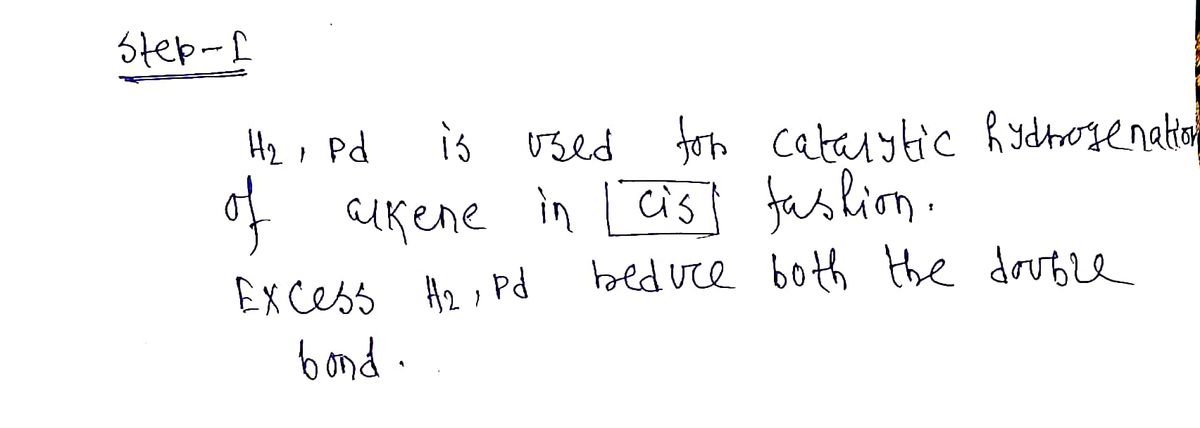Draw the structures of the organoboranes formed when borane reacts with the following alkenes, including the regiochemistry and stereochemistry as appropriate. Propose a mechanism for each reaction. (a) (b) (c) Problem 8-28 meta -Chlorobenzoic acid is not the only peroxyacid capable of epoxide formation.
Catalysts | Free Full-Text | Metal–Organic Frameworks for Electrocatalytic CO2 Reduction into Formic Acid
Introduction. Addition of hydrogen to a carbon-carbon double bond to form an alkane is a reduction reaction that is also called catalytic hydrogenation. Hydrogenation of a double bond is a thermodynamically favorable reaction because it forms a more stable (lower energy) product. In other words, the energy of the product is lower than the

Source Image: bartleby.com
Download Image
Chemistry Draw the structure or structures produced by the catalytic reduction of the given compound, in which H, is in excess. Draw hydrogen at a chirality center and use wedge-and-dash bonds to designate the stereochemistry, if applicable.

Source Image: byjus.com
Download Image
SOLVED: 1. The following reaction successfully installed an imidazole. Draw the starting material’s structure and provide intermediates after the first and second C-C bond formation steps in order to describe the reaction Science Chemistry Chemistry questions and answers Draw the structure or structures produced by the catalytic reduction of the given compound, in which H2 is in excess.

Source Image: homework.study.com
Download Image
Draw The Structure Or Structures Produced By The Catalytic Reduction
Science Chemistry Chemistry questions and answers Draw the structure or structures produced by the catalytic reduction of the given compound, in which H2 is in excess. 5.5: Catalytic Hydrogenation. Catalytic hydrogenation is a tremendously important reaction. It is an essential step in the synthesis of many fine chemicals as well as bulk commodities. In catalytic hydrogenation, a pair of hydrogen atoms are added across a double bond, turning an alkene into an alkane.
Draw one of the structure produced by the catalytic reduction of the following compounds. (H_2 is in excess.) Use wedge-and -dash bonds to indicate stereochemistry, include All hydrogen atoms on chira |
Draw one of the structure produced by the catalytic reduction of the following compounds. (Heq_2 /eq is in excess.) Use wedge-and-dash bonds to indicate stereochemistry, include all hydrogen atoms on chirality (stereo) centers. OsO4 (Osmium Tetroxide) for Dihydroxylation of Alkenes – Master Organic Chemistry

Source Image: masterorganicchemistry.com
Download Image
Alkenes – Alkene Structure and Reactivity (A-Level Chemistry) – Study Mind Draw one of the structure produced by the catalytic reduction of the following compounds. (Heq_2 /eq is in excess.) Use wedge-and-dash bonds to indicate stereochemistry, include all hydrogen atoms on chirality (stereo) centers.

Source Image: studymind.co.uk
Download Image
Catalysts | Free Full-Text | Metal–Organic Frameworks for Electrocatalytic CO2 Reduction into Formic Acid Draw the structures of the organoboranes formed when borane reacts with the following alkenes, including the regiochemistry and stereochemistry as appropriate. Propose a mechanism for each reaction. (a) (b) (c) Problem 8-28 meta -Chlorobenzoic acid is not the only peroxyacid capable of epoxide formation.

Source Image: mdpi.com
Download Image
SOLVED: 1. The following reaction successfully installed an imidazole. Draw the starting material’s structure and provide intermediates after the first and second C-C bond formation steps in order to describe the reaction Chemistry Draw the structure or structures produced by the catalytic reduction of the given compound, in which H, is in excess. Draw hydrogen at a chirality center and use wedge-and-dash bonds to designate the stereochemistry, if applicable.

Source Image: numerade.com
Download Image
Solved Draw the structure or structures produced by the | Chegg.com Draw the structure or structures produced by the catalytic reduction of the given compound, in which H, is in excess. Draw hydrogen at a chirality center and use wedge-and-dash bonds to designate the stereochemistry, if applicable.

Source Image: chegg.com
Download Image
Solved Draw the structure or structures produced by the | Chegg.com Science Chemistry Chemistry questions and answers Draw the structure or structures produced by the catalytic reduction of the given compound, in which H2 is in excess.

Source Image: chegg.com
Download Image
Selective Catalytic Reduction | Mid-West Instrument | Differential Pressure Gauges in MI 5.5: Catalytic Hydrogenation. Catalytic hydrogenation is a tremendously important reaction. It is an essential step in the synthesis of many fine chemicals as well as bulk commodities. In catalytic hydrogenation, a pair of hydrogen atoms are added across a double bond, turning an alkene into an alkane.

Source Image: midwestinstrument.com
Download Image
Alkenes – Alkene Structure and Reactivity (A-Level Chemistry) – Study Mind
Selective Catalytic Reduction | Mid-West Instrument | Differential Pressure Gauges in MI Introduction. Addition of hydrogen to a carbon-carbon double bond to form an alkane is a reduction reaction that is also called catalytic hydrogenation. Hydrogenation of a double bond is a thermodynamically favorable reaction because it forms a more stable (lower energy) product. In other words, the energy of the product is lower than the
SOLVED: 1. The following reaction successfully installed an imidazole. Draw the starting material’s structure and provide intermediates after the first and second C-C bond formation steps in order to describe the reaction Solved Draw the structure or structures produced by the | Chegg.com Draw the structure or structures produced by the catalytic reduction of the given compound, in which H, is in excess. Draw hydrogen at a chirality center and use wedge-and-dash bonds to designate the stereochemistry, if applicable.